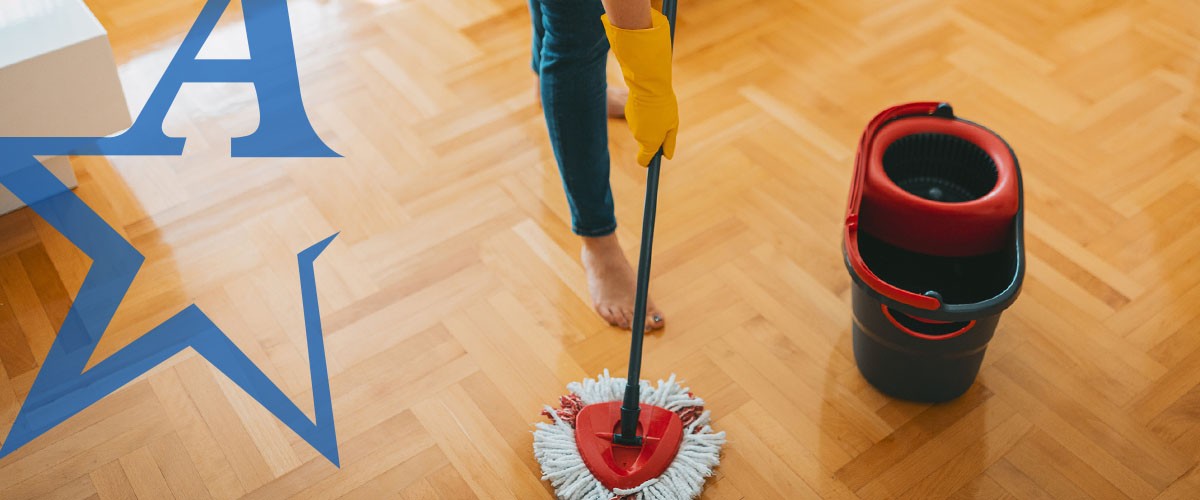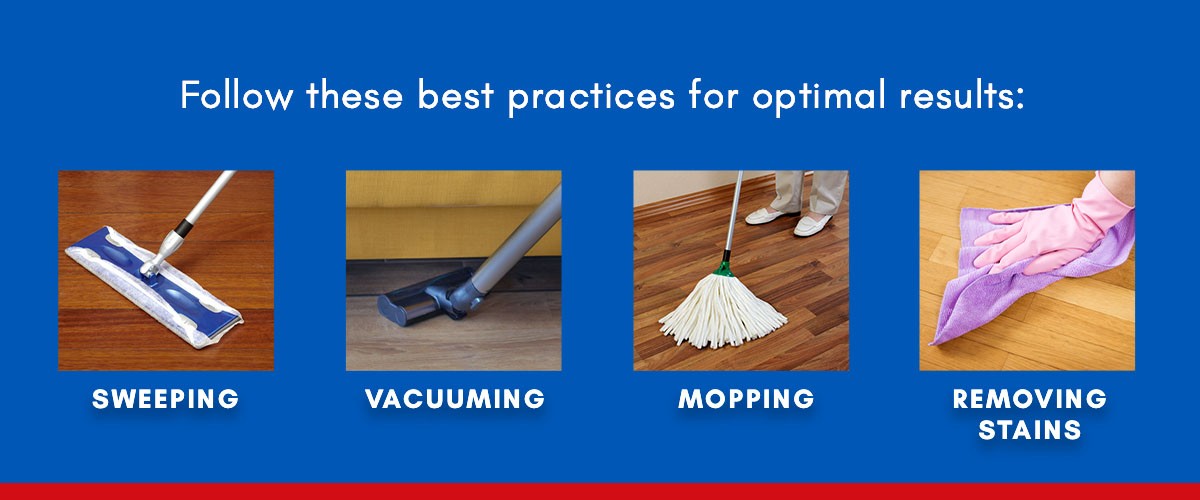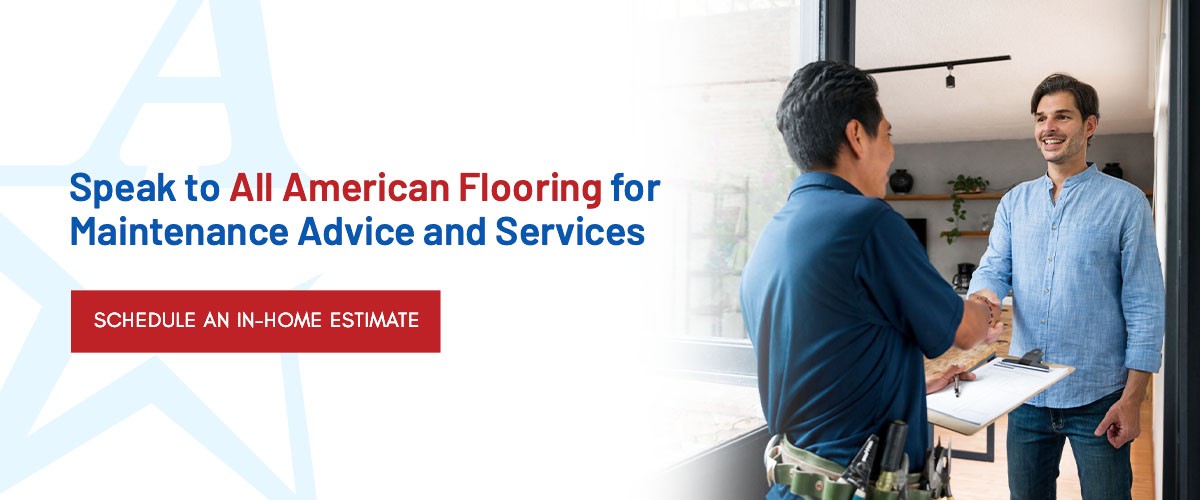Hardwood Flooring Maintenance

Many people choose hardwood flooring because of its remarkable strength and durability, sustainability, appearance and straightforward maintenance.
Hardwood flooring remains highly popular, even more so than engineered wood flooring, as you can refinish it and extend its life span. Proper cleaning and maintenance allow you to keep your hardwood floor looking immaculate for years.
What Maintenance Do Hardwood Floors Need?
Hardwood flooring is a sought-after choice for its timeless appeal. However, like all types of flooring, cleaning and maintaining hardwood takes some effort. If you live in the Dallas-Fort Worth area, your hardwood floor will experience a range of climate factors, from dirt and mud to leaves, rain and snow. Depending on seasonal changes, you may have more or less maintenance to do.
Here are some tips for easy maintenance and improving flooring longevity:
- Remove scratch-causing dirt and debris by sweeping and vacuuming regularly — daily, if needed.
- Mop with a slightly damp, but not wet, mop after removing the initial dirt layer.
- Wipe up spills quickly to avoid stains and moisture build up.
- Use rugs and mats in high-traffic areas and under moveable furniture.
- Attach furniture pads to any chairs or moveable furniture not placed on rugs.
- Keep the humidity and levels of direct sun under control, as best as possible, year-round.
- Check for signs of wear and tear and address these promptly or call a flooring company to assist.
Are Hardwood Floors Hard to Maintain?
It can be easy to maintain hardwood floors if you follow the proper guidelines for the type of wood used and pay enough attention to the flooring. The factors affecting maintenance difficulty include:
- The type of hardwood: Oak flooring is more resilient than pine, for example.
- The amount of foot traffic: If the floor is uncovered and in a busy spot, it will require more frequent and extensive maintenance.
- The type of finish used: An aluminum oxide finish is highly durable and more scratch and stain-resistant than a wood floor wax finish.
Effective Cleaning Techniques for Hardwood Floors
Maintaining a frequent cleaning routine is crucial for keeping hardwood flooring looking its best and preserving its beauty and quality. Hardwood also requires specific products and cleaning techniques that differ from those of other types of flooring.
Recommended Hardwood Floor Cleaning Products
Because some cleaning products can damage hardwood floors, it’s important to follow the recommended guidance for your floor type. If you’re not sure what products to use, you can always consult a hardwood specialist.
Some brands of oil soap are safe for cleaning hardwood floors, as they are gentle and effective at removing dirt or grime without damaging the finish. Follow the directions to avoid residue buildup or damage to your floors.
Some other safe cleaning options include:
- Water-based cleaning solutions
- pH-neutral hardwood floor cleaner
- Non-abrasive or acidic cleaning agents
- Vinegar and water mixture
- Microfiber mops and cloths, or anything non-abrasive
Floor Cleaning Techniques
Cleaning hardwood flooring is simple enough, and following the tips on sweeping, vacuuming, mopping and stain removal, you should find cleaning a breeze. Follow these best practices for optimal results:

- Sweeping: Depending on the level of foot traffic, you may need to sweep with a soft-bristle brush daily to remove dust and dirt that can scratch your flooring if left unattended.
- Vacuuming: Set your vacuum for hard or bare surfaces and check if it has a hardwood floor attachment. Avoid using a beater bar or brushes as they could scratch the surface. Additionally, ensure that your vacuum has smooth and non-abrasive wheels.
- Mopping: Use a damp microfiber mop head to clean the floors after sweeping or vacuuming. Use one of the recommended hardwood cleaning products and avoid excessive water. You might spot mop busy areas daily if needed, but you can do this weekly.
- Removing stains: For existing stains on your wood floor, use a specialized hardwood floor cleaner or a mixture of vinegar and water. If the stains are oil-based, use a small amount of gentle dish soap mixed with water. Additionally, if you painted a room with hardwood flooring and some spilled, it is simple enough to remove paint if done correctly. When removing stains, always test the solution on an inconspicuous area first.
Protecting and Repairing Your Hardwood Floors
Protecting your hardwood floors begins with knowing what might damage the flooring, how to protect the floor and potentially repair that damage if it occurs.
Scratch Prevention Strategies
To prevent scratch marks on your immaculate flooring, use furniture pads under the legs, especially for movable furniture and place rugs or carpets in high-traffic areas.
If you have pets, protect your hardwood floors by keeping their nails trimmed neatly, and use pet-friendly rugs in areas they spend the most time in to minimize any chance of claw marks.
Damage Repair Options
You can always use wood floor repair kits for minor scratches, which are effective for smaller and less noticeable jobs. However, it is highly advisable to seek professional services for more complex repairs, particularly if there are deep marks or gouges and other extensive damage. Speaking with your local Dallas, Fort Worth area flooring experts will ensure your flooring gets restored correctly and lasts for a long time.
Maintaining the Longevity of Your Hardwood Floors
Apart from cleaning and general maintenance, you will need to refinish your hardwood floors and ensure moisture control periodically.
Refinishing Hardwood Floors
If you think you see signs that you need to replace your hardwood flooring, be sure to consider whether refinishing might be a better alternative, mainly if dealing with surface damage, as opposed to severe structural damage. According to the National Wood Flooring Association (NWFA) it is advisable to refinish every three to five years to help keep your floor well maintained.
When a flooring specialist refinishes your hardwood floor, they typically sand down the top layer to remove any stains, scratches and other imperfections. Then, to refinish the floor, they will apply a new finish. The kind of finish depends on the type of wooden flooring — the finish restores the hardwood and helps to protect it. The process is excellent for rejuvenating old and worn floors and extends their life span.
Moisture Control for Hardwood Floors
Hardwood floors require proper moisture control to prevent potential damage and keep them in prime condition. A few measures to consider incorporating include:
- Using a dehumidifier when the conditions are muggy and humid.
- Maintaining consistently low indoor humidity levels.
- Placing mats at entrances to the houses or removing wet shoes.
- Limiting the amount of water you use when cleaning.
- Wiping up spills immediately afterward.
Speak to All American Flooring for Maintenance Advice and Services
If you need help choosing the right hardwood flooring for your home or business or professional assistance with routine hardwood floor maintenance, contact All American Flooring for professional advice and services.
We also offer re-finishing, re-screening and re-staining of hardwood floors. With over 35 years of serving the Dallas-Fort Worth Metroplex, we are your go-to hardwood flooring specialists. So be sure to book your free on-site consultation today!



